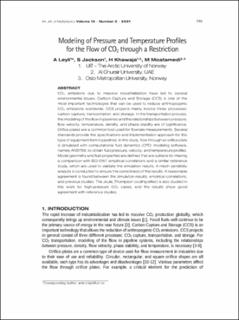| dc.contributor.author | Leyli, Amir Nadem | |
| dc.contributor.author | Jackson, Steven | |
| dc.contributor.author | Khawaja, Hassan | |
| dc.contributor.author | Moatamedi, Mojtaba | |
| dc.date.accessioned | 2021-05-11T11:02:39Z | |
| dc.date.available | 2021-05-11T11:02:39Z | |
| dc.date.created | 2021-04-19T14:33:20Z | |
| dc.date.issued | 2021-04-19 | |
| dc.identifier.citation | The International Journal of Multiphysics. 2021, 15 (2), 235-250. | en_US |
| dc.identifier.issn | 1750-9548 | |
| dc.identifier.uri | https://hdl.handle.net/11250/2754858 | |
| dc.description.abstract | CO2 emissions due to massive industrialization have led to several environmental issues. Carbon Capture and Storage (CCS) is one of the most important technologies that can be used to reduce anthropogenic CO2 emissions worldwide. CCS projects mainly involve three processes: carbon capture, transportation, and storage. In the transportation process, the modeling of the flow in pipelines and the relationships between pressure, flow velocity, temperature, density, and phase stability are of significance. Orifice plates are a common tool used for flowrate measurements. Several standards provide the specifications and implementation approach for this type of equipment item in pipelines. In this study, flow through an orifice plate is simulated with computational fluid dynamics (CFD) modeling software, namely ANSYS®, to obtain fluid pressure, velocity, and temperature profiles. Model geometry and fluid properties are defined that are suitable for making a comparison with ISO-5167 empirical correlations and a similar reference study, which are used to validate the simulation results. A mesh sensitivity analysis is conducted to ensure the correctness of the results. A reasonable agreement is found between the simulation results, empirical correlations, and previous studies. The Joule Thompson cooling effect is also considered in this work for high-pressure CO2 cases, and the plots showed good agreement with reference studies. | en_US |
| dc.description.sponsorship | The publication charges for this article were funded by a grant from the publication fund of UiT-The Arctic University of Norway. | en_US |
| dc.language.iso | eng | en_US |
| dc.publisher | International Society of Multiphysics | en_US |
| dc.relation.ispartofseries | International Journal of Multiphysics;15 (2) | |
| dc.rights | Navngivelse 4.0 Internasjonal | * |
| dc.rights.uri | http://creativecommons.org/licenses/by/4.0/deed.no | * |
| dc.subject | Pressure models | en_US |
| dc.subject | Temperature profiles | en_US |
| dc.subject | CO2 emissions | en_US |
| dc.subject | Environmental issues | en_US |
| dc.title | Modeling of Pressure and Temperature Profiles for the Flow of CO2 through a Restriction | en_US |
| dc.type | Journal article | en_US |
| dc.type | Peer reviewed | en_US |
| dc.description.version | publishedVersion | en_US |
| dc.rights.holder | Copyright (c) 2021 A Leyli, S Jackson, H Khawaja, M Moatamedi | en_US |
| cristin.ispublished | true | |
| cristin.fulltext | original | |
| cristin.fulltext | original | |
| cristin.qualitycode | 1 | |
| dc.identifier.doi | https://doi.org/10.21152/1750-9548.15.2.235 | |
| dc.identifier.cristin | 1905115 | |
| dc.source.journal | The International Journal of Multiphysics | en_US |
| dc.source.volume | 15 | en_US |
| dc.source.issue | 2 | en_US |
| dc.source.pagenumber | 235-250 | en_US |

